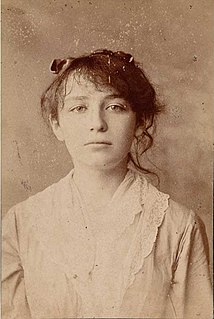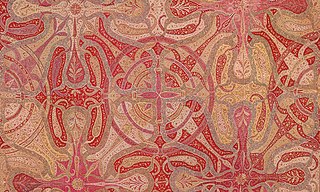Related Research Articles

Camille Rosalie Claudel was a French sculptor known for her figurative works in bronze and marble. She died in relative obscurity, but later gained recognition for the originality and quality of her work. The subject of several biographies and films, Claudel is well known for her sculptures including The Waltz and The Mature Age.

Sexual themes are frequently used in science fiction or related genres. Such elements may include depictions of realistic sexual interactions in a science fictional setting, a protagonist with an alternative sexuality, a sexual encounter between a human and a fictional extraterrestrial, or exploration of the varieties of sexual experience that deviate from the conventional.

Their Eyes Were Watching God is a 1937 novel by American writer Zora Neale Hurston. It is considered a classic of the Harlem Renaissance, and Hurston's best known work. The novel explores main character Janie Crawford's "ripening from a vibrant, but voiceless, teenage girl into a woman with her finger on the trigger of her own destiny".

Gytha Ogg is a character from Terry Pratchett's Discworld series. She is a witch and member of the Lancre coven.

Slut is generally a term for a person, usually a woman or girl, who is considered to have loose sexual morals or who is sexually promiscuous. It is usually used as an insult, sexual slur or offensive term of disparagement (slut-shaming). It originally meant "a dirty, slovenly woman", and is rarely used to refer to men, generally requiring clarification by use of the terms male slut or man whore.

Cressida is a character who appears in many Medieval and Renaissance retellings of the story of the Trojan War. She is a Trojan woman, the daughter of Calchas, a Greek seer. She falls in love with Troilus, the youngest son of King Priam, and pledges everlasting love, but when she is sent to the Greeks as part of a hostage exchange, she forms a liaison with the Greek warrior Diomedes. In later culture she becomes an archetype of a faithless lover.

Witches Abroad is the twelfth Discworld novel by Terry Pratchett, originally published in 1991.

The mountain goat, also known as the Rocky Mountain goat, is a hoofed mammal endemic to mountainous areas of western North America. A subalpine to alpine species, it is a sure-footed climber commonly seen on cliffs and ice.

Pashmina refers to a fine variant of spun cashmere, the animal-hair fibre forming the downy undercoat of the Changthangi goat. The word pashm means "wool" in Persian, but in Kashmir, pashm referred to the raw unspun wool of domesticated Changthangi goats. In common parlance today, pashmina may refer either to the material or to the variant of the Kashmir shawl that is made from it. Both generic cashmere and pashmina come from the same goat, but generic cashmere ranges from 12 to 21 microns in diameter, whereas pashmina refers only to those fibres that range from 12 to 16 microns.
Bliss is a Canadian-produced, half-hour dramatic television series, produced by Montreal-based Galafilm and Toronto-based Back Alley Films, an anthology of women's erotica. The series ran from 2002 to 2004.

Thurlby is a village and civil parish in the South Kesteven district of Lincolnshire, England. It is situated just west of the A15 road, 2 miles (3 km) south from the town of Bourne, and on the edge of the Lincolnshire Fens. It is sometimes referred to as Thurlby by Bourne to distinguish it from other villages in Lincolnshire with the same name. Thurlby and the hamlet of Northorpe to its north are conjoined. The parish had a population of 2,136 at the 2001 census and 2,153 at the 2011 census.
The Churel, also spelled as Charail, Churreyl, Chudail, Chudel, Chuṛail, Cuḍail or Cuḍel is a mythical or legendary creature resembling a woman, which may be a demoniacal revenant said to occur in South Asia and Southeast Asia, particularly popular in India, Bangladesh and Pakistan. The churel is typically described as "the ghost of an unpurified living thing", but because she is often said to latch on to trees, she is also called a tree-spirit. According to some legends, a woman who dies during childbirth or pregnancy or from suffering at the hands of her in-laws will come back as a revenant churel for revenge, particularly targeting the males in her family.

The Mystery at the Moss-Covered Mansion is the eighteenth volume in the Nancy Drew Mystery Stories series published by Grossett & Dunlap, and was first published in 1941. The original text was written by ghostwriter Mildred Wirt Benson, based upon a plot outline from Stratemeyer Syndicate co-owner Harriet Stratemeyer Adams. The book's title was changed to Mystery of the Moss-Covered Mansion when it was revised in 1971, because the story is completely different and not much of the investigation takes place at the title location. In the original, many plots and much investigation all tie back to the same house deep in the forest, while Nancy helps her father locate an heiress, expose an impostor, investigate a murder, and look into strange screams at the mansion; none of the action in the original story took place in River Heights.

The Robber Bridegroom is a musical with a book and lyrics by Alfred Uhry and music by Robert Waldman. The story is based on the 1942 novella by Eudora Welty of the same name, with a Robin Hood-like hero; the adaptation placed it in a late 18th-century American setting. The musical ran on Broadway in 1975 and again in 1976.

Iara, also spelled Uiara, Yara or Hiara or Mãe das Águas, is a figure from Brazilian mythology based on ancient Tupi and Guaraní mythology. The word derives from Old Tupi yîara = y ("water") + îara = "lady of the lake". Depending on the oral tradition and the context of the story, she can be seen either as a water nymph, a siren, or a beautiful mermaid that lives in the Amazon River.

The domestic goat or simply goat is a domesticated species of goat-antelope typically kept as livestock. It was domesticated from the wild goat of Southwest Asia and Eastern Europe. The goat is a member of the animal family Bovidae and the subfamily Caprinae, meaning it is closely related to the sheep. There are over 300 distinct breeds of goat. It is one of the oldest domesticated species of animal, according to archaeological evidence that its earliest domestication occurred in Iran at 10,000 calibrated calendar years ago.

Woman Hollering Creek and Other Stories is a book of short stories published in 1991 by San Antonio-based Mexican-American writer Sandra Cisneros. The collection reflects Cisneros's experience of being surrounded by American influences while still being familially bound to her Mexican heritage as she grew up north of the Mexico-US border.
A girlfriend is a female friend, acquaintance or partner, usually a female companion with whom one is platonically, romantically or sexually involved.

The Bracelets of Submission are a pair of metal bracelets or cuffs worn by Wonder Woman and other Amazons. They were an original creation by William Moulton Marston as an allegory for his philosophy on loving submission and the emotional control associated with it in order to balance out the strength of the human ego. The bracelets have thus far proven indestructible to attacks, allowing Wonder Woman to deflect impacts from Firearms of all sizes, as well as melee weapons, such as swords and axes. They are also impervious to, fire, energy blasts, as well as other projectile weaponry, ranging from shells, to arrows. The bracelets are also able to negate any impact(so far), and are therefore make Diana immune to fall damage.

Dhon Cholechā is a Nepalese folk tale about a little girl and an old nanny goat. It is the most well known children's story in Newar society of the Kathmandu Valley. It tells about a little girl named Punthakhu Mainchā and the ill treatment she suffers at the hands of her cruel step-mother. Dhon Cholechā means "old nanny goat" in Nepal Bhasa.
References
- ↑ Augé, Claude. Nouveau Petit Larousse Illustré. (1934)
- ↑ Editorial board. Oxford English Dictionary (1971) ISBN 0-19-861117-X }
- ↑ Musée Rodin, Paris